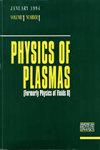Microtearing mode in electron temperature pedestal evolution and collapse of KSTAR H-mode plasmas
IF 2.2
3区 物理与天体物理
Q3 PHYSICS, FLUIDS & PLASMAS
引用次数: 0
Abstract
While the electron transport barrier remains in its final form before an edge-localized mode crash, edge turbulence manifests as fluctuations in electron temperature. Because edge turbulence is closely related to the evolution and collapse of pedestal, the microscopic spatial structure and dynamics of electron temperature fluctuations during the electron temperature pedestal evolution phase are studied using broadband electron cyclotron emission measurements. The cross phase between the electron temperature and potential fluctuations is evaluated using a velocimetry technique to identify the nature of turbulence. A comprehensive comparison of the properties of various instabilities confirms that the micro-tearing mode is a leading candidate associated with the electron temperature pedestal evolution and collapse. The quadratic transfer function reveals that the energy within the pedestal is nonlinearly transferred to the interior of the electron temperature pedestal before the pedestal collapse, resulting in radial change in the mode structure and dynamics.KSTAR H 模等离子体电子温度基座演化和坍缩中的微撕裂模式
当电子传输障壁在边缘局部模式崩溃前保持最终形态时,边缘湍流表现为电子温度的波动。由于边缘湍流与基座的演化和崩溃密切相关,因此利用宽带电子回旋发射测量对电子温度基座演化阶段的电子温度波动的微观空间结构和动力学进行了研究。利用测速技术评估了电子温度和电势波动之间的交叉相位,以确定湍流的性质。对各种不稳定性性质的综合比较证实,微撕裂模式是与电子温度基座演化和坍缩相关的主要候选模式。二次传递函数显示,基座内的能量在基座坍塌前非线性地传递到电子温度基座内部,导致模式结构和动力学的径向变化。
本文章由计算机程序翻译,如有差异,请以英文原文为准。
求助全文
约1分钟内获得全文
求助全文
来源期刊

Physics of Plasmas
物理-物理:流体与等离子体
CiteScore
4.10
自引率
22.70%
发文量
653
审稿时长
2.5 months
期刊介绍:
Physics of Plasmas (PoP), published by AIP Publishing in cooperation with the APS Division of Plasma Physics, is committed to the publication of original research in all areas of experimental and theoretical plasma physics. PoP publishes comprehensive and in-depth review manuscripts covering important areas of study and Special Topics highlighting new and cutting-edge developments in plasma physics. Every year a special issue publishes the invited and review papers from the most recent meeting of the APS Division of Plasma Physics. PoP covers a broad range of important research in this dynamic field, including:
-Basic plasma phenomena, waves, instabilities
-Nonlinear phenomena, turbulence, transport
-Magnetically confined plasmas, heating, confinement
-Inertially confined plasmas, high-energy density plasma science, warm dense matter
-Ionospheric, solar-system, and astrophysical plasmas
-Lasers, particle beams, accelerators, radiation generation
-Radiation emission, absorption, and transport
-Low-temperature plasmas, plasma applications, plasma sources, sheaths
-Dusty plasmas
 求助内容:
求助内容: 应助结果提醒方式:
应助结果提醒方式:


